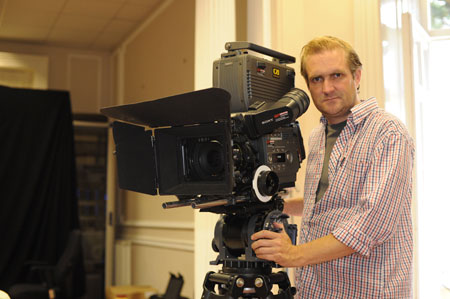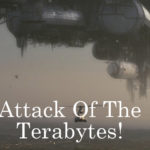
Why I bought a Sony F35 cinematography camera by Dan Mulligan
Posted on Dec 1, 2009 by Alex Fice
Dan Mulligan and his f35 cameraIt is maybe as a result of the slickness of the RED camera marketing that Sony’s launch of their significant F35 digital cinematography camera has slipped by almost unnoticed even with the combined marketing skills of Band Pro and Rogue Element Films. In fact Dan Mulligan of Rogue Element, buyers of the first F35 in Europe, has found himself somewhat defending himself: “People have been asking ‘Why did you buy that, why didn’t you buy a RED?’”.
SO DAN, WHY DID YOU BUY THE F35?
“We looked at REDs but we buy kit like Vipers and F35s for the longevity of the products and the company back up and for us the ultimate in quality regardless of price. The RED is obviously an exciting product but potentially flawed for all sorts of reasons. If you’re prepared to put up with it you will get some lovely results but nothing more than a F900R/F23 that’s set up properly.
“I buy kit that tends to be the right product for the right job and the clients come to me because we offer almost a niche service. We treat it in a mature fashion, we look at real results using a hardware based delivery. The Viper is a 4k camera delivering a 2k deliverable on-set, for real, to SR tape or Stwo DFRs as DPX data. Yet most people shooting with a RED recently are saying ‘The best way to shoot with RED is to get the 4k images, de-bayer them and dump them on to SR for 2k mastering’. I was shooting Vipers to SR four or five years ago.
“There’s still a lack of awareness of what digital is out there and not many fully understand it really. The loss leader price of a RED at $17,000 is such a massive red herring because by the time you spec it properly you’re looking at the same sort of rental costs as a decent F23 system. The F23 and F35 image quality and delivery is much better but nobody will believe you.
“The democratising that the RED brings is actually in danger of splitting digital apart and I find myself almost defending my purchase of the F35, a much superior camera system in many ways. Most users recognise the F35’s build and quality and the camera wipes the floor with RED on any test on any workflow option, except that bottom line marquee price point. It’s got 14 stops, the RED’s only got 10-11. What’s damaging about the RED is that there will come a time in two or three years when people will be saying lovely images but what a difficult beast too use and post.
5K TO 2K
“Our talent is making it simple with these cameras, stripping away the mystery of digital. We tell people not to get bogged down with the technology. Think of the lens, think of the chip, think of it as film, think log, think digital negative. Treat it like a film camera, the only difference is you’re capturing a digital negative not a film neg. Once you get your head around that, it becomes so easy. Things like the RED are just over complicating the issue.
“The F35 is a 5k chip sub-sampling down to 2k to give you a usable delivery format. You’ve got 14 stops, 14 bit dynamic range, the same as film. We hook up the F35 to the STwo DFRs to capture that DPX frame at source so we’re treating it as a digital negative.
“You know when you buy from companies like Band Pro that your partnering with a support structure that will help when anything goes wrong. You know that Sony are continually working on making the camera better and you’re buying a camera body that will last at least five or six years before it is superseded.
“Focus pullers are struggling for work on some REDs, they’re being self operated like an ENG camera, so the actual craft of making a film is being lost or diluted. We’re approaching our digital shoots as if it was a film shoot with the difference being a digital camera. So its digital neg, DPX frames as film neg, we offline, we telecine, we colour time the images, and we archive as you would do with film by duping the neg. When we talk to producers we are saying this is exactly how you would have shot a film with the disciplines and the people in place and with a tried and tested workflow. The difference is that your telecine machine is a now a machine you can have in your hotel, the archive can happen close to the location and we can also process on-set. Which means we can bring someone from editorial on-set, not a data guy but an editor who can log shots and the people driving the DFR machines are camera assistants. We’re taking a very film centric approach to shooting digitally.”








